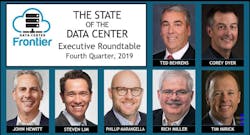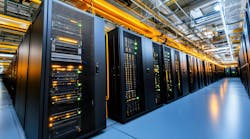Welcome to our 17th Data Center Executive Roundtable, a quarterly feature showcasing the insights of thought leaders on the state of the data center industry, and where it is headed. Our Fourth Quarter 2019 roundtable provides a look ahead into 2020, as our panel offers insights on four topics: the top data center trends for 2020, predictions for the coming year in hyperscale computing, an update on the industry’s looming staffing crisis, and the state of the market for edge computing services.
Here’s a look at our distinguished panel:
- Tim Mirick, Senior Vice President Leasing & Marketing at Sabey Data Centers.
- Steven Lim, Senior Vice President of Marketing and Product at RagingWire/NTT Global Data Centers.
- Corey Dyer, Executive Vice President, Global Sales & Marketing, at Digital Realty.
- John Hewitt, President of the Americas for Vertiv.
- Ted Behrens , Executive Vice President of Global Engineering, Product Management & Marketing for Chatsworth Products.
- Phillip Marangella, the Chief Marketing Officer at EdgeConneX.
The conversation is moderated by Rich Miller, the founder and editor of Data Center Frontier. Each day this week we will present a Q&A with these executives on one of our key topics. We begin with a look at our panel’s predictions for the data center industry for 2020.
Data Center Frontier: What is the one trend you believe will be the most significant in shaping the data center industry in 2020, and why?
COREY DYER, Digital Realty
Corey Dyer: 2020 will be a big year for digital transformation. With technologies such as 5G, artificial intelligence (AI) and blockchain creating new possibilities, and organizations feeling the pressures of digital transformation, both private and public enterprises across all industries are going to need to transform their IT infrastructure so that they can operate globally and on-demand.
However, as most IT teams know, modifying IT environments to stay ahead of business demands is a challenging task, and often easier said than done. Enterprises are becoming increasingly buried in data due to AI, IoT and data analytics, and it becomes harder and harder to move. This is “data gravity” and it can completely derail a digital transformation strategy. If IT teams aren’t taking the right steps to manage their data, they’ll have massive amounts of data generated and stored in separate data centers, clouds, and edge locations, which can cause latency issues. This explosion of data will cause an exponential demand for more data center resources and power.
To avoid the perils of data gravity and be able to scale digital businesses, enterprises will need to re-architect towards a decentralized infrastructure that accommodates distributed workflows from multi-cloud to edge. We also expect customers to have a more global strategy, and as a result, will need to be able to be closer to their points of data. We’ll also see more companies gravitate towards providers who can support them globally.
JOHN HEWITT, Vertiv
John Hewitt: It’s not new, but the answer has to be continued growth at the edge of the network, and that’s true in what we think about as the traditional data center space as well as any number of verticals, including healthcare, retail, education, and the federal government sector. Consider this data point from our recent Data Center 2025 survey: Among survey participants who have edge sites today or expect to have them in 2025, that group collectively expects their total number of edge sites to increase by 226% by 2025.
This is happening because there are more and more applications that require computing closer to the end user. As we continue to see more adoption of artificial intelligence and rollout of 5G networks, this is only going to increase and accelerate.
TIM MIRICK, Sabey Data Centers
Tim Mirick: We have been watching the steady migration of enterprises out of owned data centers and believe that will accelerate in 2020. This has been a trend for some time, but big moves take significant planning, and in some cases disposition of real estate assets and new staffing plans.
Based on demand, and with the number of sale/leasebacks that we have seen over the last several years (which provides time for transition planning), I believe we will see increased activity.
This will create incremental demand in the cloud and colocation market as they architect optimized hybrid deployments, leveraging the best of what they do with colocation and cloud capabilities.
STEVEN LIM, RagingWire/NTT
Steven Lim: In 2020, the sense of urgency toward supporting a sustainable future for our planet will be front and center in every industry, especially data centers. Some ways we can improve sustainability within our industry include:
- Partner with your utility – As we build new data centers around the country, we are working with local providers such as Dominion Energy, Garland Power & Light, Portland General Electric and others to provide renewable energy options. This approach worked well in Sacramento, where our Northern California data center clients receive 100% renewable energy at stable prices that are the lowest in the state, without being exposed to market fluctuations. This renewable energy package came about from a partnership we forged with the Sacramento Municipal Utility District (SMUD), with whom we participate in their Greenergy and Large Commercial SolarShares programs. Greenergy allows business customers to purchase up to 100 percent of their electricity from renewable resources such as wind, water, sun and biomass. Large Commercial SolarShares allows large businesses in the Sacramento region to purchase solar energy directly from SMUD. We’re quite proud that our renewable energy agreement is the largest with a private sector company in SMUD’s 70-year history.
- Run all data center operations at peak efficiency – By implementing a wireless environmental monitoring system to provide a detailed thermal map of the data floor, we can make precise temperature and humidity adjustments to save cooling energy. We carefully increased chilled water temperatures from the initial plant design temperature of 45°F to about 60°F, which resulted in energy savings of as much as 30%. In addition, after being permanently loaded just one time, water in this closed loop does not need to be refilled. We leverage the right technology for a given environment, which enables us to go 100% waterless where possible. For instance, at our Dallas TX1 Data Center, we have installed one of the largest water-free mechanical systems in the U.S., which leverages cool air from outside and does not stress local water supplies.
- Look at all sustainability opportunities – Find ways to use more recycled materials, such as buying carpet from recycled fishnet. We recycle 100% of the cardboard, steel, copper, glass, plastic, aluminum, and other eligible materials, and we recycle 100% of our lead acid and VRLA batteries, and all the electronic waste from our own company use and as a free service to our clients.
TED BEHRENS, Chatsworth Products
Ted Behrens: After many years of forecasting the rise in cabinet densities, the industry has finally hit the inflection point of cabinet densities rising well into the double-digit kW range. To be sure, this rise is being driven by an increased IT application demand, but it’s also a result of the maturing infrastructure technologies used to support such loads. For example, thermal segregation of air through hot or cold aisle containment is still a relevant practice that supports upwards of 30kW loads if deployed appropriately.
Another growing trend, particularly in the United States, is the slow and steady transition from 480/208 VAC to 415/240 VAC power feeds. U.S. data centers are making the switch mainly due to recent advances in uninterruptible power supply (UPS)—including the introduction of transformerless UPSs and Energy-Saver Mode. As the last leg of the power chain, demand for intelligent power distribution units (PDUs) is also expected to increase.
Phillip Marangella, Chief Marketing Officer, EdgeConneX
Phillip Marangella: From a market perspective, AI and cloud gaming become pervasive, which in turn drives more cloud deployments at the edge to enable both of those trends.
From an industry perspective, consolidation will continue with infrastructure capital continuing to enter the data center market.
And lastly, from a technological perspective, the drive for more sustainable solutions will evolve so that the growth in renewable power solutions will start bringing power to the grid and not just the data center.
NEXT: A look at what we can expect from the hyperscale computing sector in 2020.
Keep pace with the fact-moving world of data centers and cloud computing by following us on Twitter and Facebook, connecting with me on LinkedIn, and signing up for our weekly newspaper using the form below:
About the Author



